
Sinclair Mk14 Replica
Posted by musovern on Feb 7th, 2025 in Sinclair, Single Board Computers, Uncategorized | 0 comments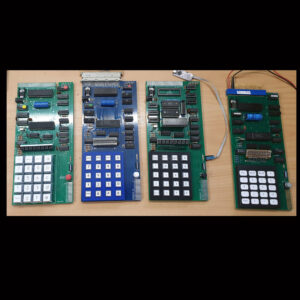 The MK14 (Microcomputer Kit 14) was a computer kit sold by Science of Cambridge of the United Kingdom, first introduced in 1977 for £39.95. The price was very low for a complete computer system at the time, and Science of Cambridge eventually sold over fifteen thousand kit The computer is based around National Semiconductor’s SC/MP CPU (INS8060) and shipped with 256 bytes of random-access memory (RAM) and 512 bytes of read-only memory (ROM) as standard. It used an eight or nine red light-emitting diode (LED) seven segment display, there was also optional VDU supporting 32×16 text or 64×64... Read More...
The MK14 (Microcomputer Kit 14) was a computer kit sold by Science of Cambridge of the United Kingdom, first introduced in 1977 for £39.95. The price was very low for a complete computer system at the time, and Science of Cambridge eventually sold over fifteen thousand kit The computer is based around National Semiconductor’s SC/MP CPU (INS8060) and shipped with 256 bytes of random-access memory (RAM) and 512 bytes of read-only memory (ROM) as standard. It used an eight or nine red light-emitting diode (LED) seven segment display, there was also optional VDU supporting 32×16 text or 64×64... Read More...
Dick Smith Super 80
Posted by musovern on May 2nd, 2023 in Dick Smith Super 80 | 0 comments Got this Super80 in the big tech sale Auckland 2020. A little bit about the Super 80 The Dick Smith Super-80 was a Zilog Z80 based kit computer developed as a joint venture between Electronics Australia magazine and Dick Smith Electronics. It was presented as a series of construction articles in Electronics Australia magazine’s August, September and October 1981 issues. Electronics Australia had published a number of computer projects before the Super-80, including the EDUC-8 in 1974, the Mini Scamp and the DREAM 6800 Video Computer. The computer was sold as a “short form” kit for A$... Read More...
Got this Super80 in the big tech sale Auckland 2020. A little bit about the Super 80 The Dick Smith Super-80 was a Zilog Z80 based kit computer developed as a joint venture between Electronics Australia magazine and Dick Smith Electronics. It was presented as a series of construction articles in Electronics Australia magazine’s August, September and October 1981 issues. Electronics Australia had published a number of computer projects before the Super-80, including the EDUC-8 in 1974, the Mini Scamp and the DREAM 6800 Video Computer. The computer was sold as a “short form” kit for A$... Read More...
Apple II Rev 0
Posted by musovern on Aug 12th, 2022 in Apple | 1 comment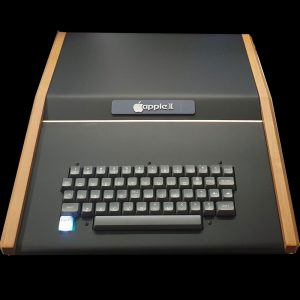 Background on the Apple II Rev 0 Replica The first 6000 or so Apple II’s sold, were equipped with what is called a revision 0 motherboard. A number of Apple II motherboards were also sold at the same time without case, keyboard or power supply. Most of these bare board systems were revision 0. One of these early machines was my personal Apple II. At some point, when the machine was on loan to a family member’s business, the original rev 0 board failed. It was repaired via replacing the motherboard with a rev 3 board. Over the last few years, I’ve been working to restore the... Read More...
Background on the Apple II Rev 0 Replica The first 6000 or so Apple II’s sold, were equipped with what is called a revision 0 motherboard. A number of Apple II motherboards were also sold at the same time without case, keyboard or power supply. Most of these bare board systems were revision 0. One of these early machines was my personal Apple II. At some point, when the machine was on loan to a family member’s business, the original rev 0 board failed. It was repaired via replacing the motherboard with a rev 3 board. Over the last few years, I’ve been working to restore the... Read More...
Amstrad PPC512 Portable Personal Computer
Posted by musovern on May 12th, 2022 in Amstrad, Vintage Computers | 0 comments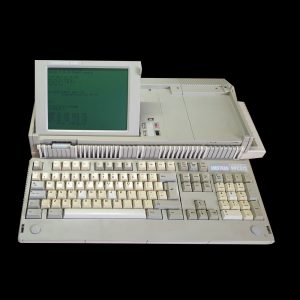 The PPC512 had an NEC V30 processor running at 8 MHz, 512 KiB of memory, a full-size 102-key keyboard with a numeric keypad, a built-in liquid crystal display (not backlit)[1] that could emulate the CGA or MDA and either one or two 720k 3.5″ floppy drives (the model was either the PPC512S or PPC512D depending on the number of drives it had). The PPC640 was otherwise identical except that it had 640 KiB of memory, a built-in 2400 baud modem (unusually fast for its day), and its case was a darker shade of grey. Both versions of the machine had an empty socket on the main circuit board so that an... Read More...
The PPC512 had an NEC V30 processor running at 8 MHz, 512 KiB of memory, a full-size 102-key keyboard with a numeric keypad, a built-in liquid crystal display (not backlit)[1] that could emulate the CGA or MDA and either one or two 720k 3.5″ floppy drives (the model was either the PPC512S or PPC512D depending on the number of drives it had). The PPC640 was otherwise identical except that it had 640 KiB of memory, a built-in 2400 baud modem (unusually fast for its day), and its case was a darker shade of grey. Both versions of the machine had an empty socket on the main circuit board so that an... Read More...
OSI Superboard RevD
Posted by musovern on Feb 14th, 2022 in Ohio Scientific | 0 comments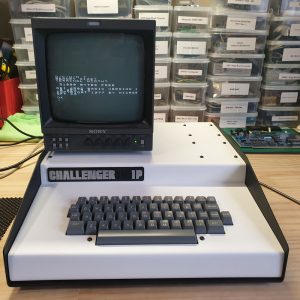 This is my OSI Challenger C1P Superboard RevD Starting to Populate the PCB Klyball 600D Next up testing the System with the CEGMON ROM and added the cherry MX switches with a custom keycap set. I’ll add a home made RAM upgrade so I have 32k RAM Installed 32K RAM-UPGRADE Now to start on a case I had some spare alloy from another project. Did a rough size up of the C1P. Thanks Philip Keyboard cutout. Did the cutout for the keyboard and made up a rough 3D printed badge for the size of my case. Thanks again Philip for the Font. Final test fit now with the bottom Aluminum case part made just needs a... Read More...
This is my OSI Challenger C1P Superboard RevD Starting to Populate the PCB Klyball 600D Next up testing the System with the CEGMON ROM and added the cherry MX switches with a custom keycap set. I’ll add a home made RAM upgrade so I have 32k RAM Installed 32K RAM-UPGRADE Now to start on a case I had some spare alloy from another project. Did a rough size up of the C1P. Thanks Philip Keyboard cutout. Did the cutout for the keyboard and made up a rough 3D printed badge for the size of my case. Thanks again Philip for the Font. Final test fit now with the bottom Aluminum case part made just needs a... Read More...
OSI Replica Computer
Posted by musovern on Jun 25th, 2021 in Ohio Scientific | 0 comments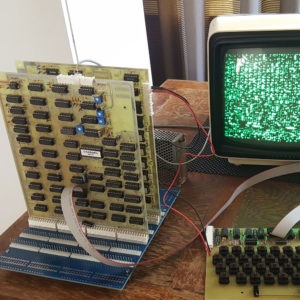 Getting a OSI Challenger system together Test setup Have finished the keyboard OSI 505 board OSI 560Z OSI 502 OSI 540b CP4 setup working Floppy Disk and Gotek working Read More...
Getting a OSI Challenger system together Test setup Have finished the keyboard OSI 505 board OSI 560Z OSI 502 OSI 540b CP4 setup working Floppy Disk and Gotek working Read More...
2650 Mini Computer
Posted by musovern on Feb 15th, 2020 in 2650-mini-computer, Vintage Computers | 0 comments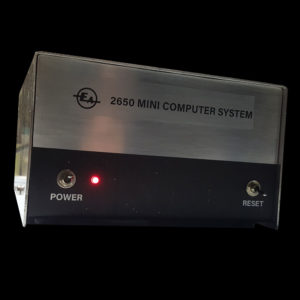 A remake of the EA 2650 mini system In May 1978, Electronics Australia described a small development board based on the Signetics 2650 microprocessor. For many people in Australia (the author included), this was the first computer that was cheap enough to buy and build even if you were a student or beginner. This update to the simple and elegant design of the original provides a new PCB that evokes the original while adding modern alternatives to some of the hard-to-get parts of the original. The original article text is included at the end of this document The new board has three options over the... Read More...
A remake of the EA 2650 mini system In May 1978, Electronics Australia described a small development board based on the Signetics 2650 microprocessor. For many people in Australia (the author included), this was the first computer that was cheap enough to buy and build even if you were a student or beginner. This update to the simple and elegant design of the original provides a new PCB that evokes the original while adding modern alternatives to some of the hard-to-get parts of the original. The original article text is included at the end of this document The new board has three options over the... Read More...
Apple II Plus
Posted by musovern on Feb 3rd, 2020 in Apple, Vintage Computers | 0 comments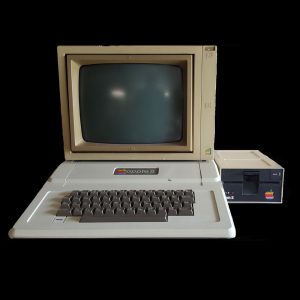
The Apple II+ was the successor of the Apple II.
It was fully compatible with the Apple II, however, has some new features: a new ROM containing the AppleSoft Basic (floating point version written by Microsoft), a new auto-start (store in ROM) for easier start-up and screen editing, 48 KB RAM, text modes were the same as the
Apple II, but the graphic modes were enhanced. They’re the same as the Apple 2e: 16 colors with low resolution and 6 colors with high resolution. In fact the 6-color mode was also available on the Apple II since the revision 1 of the motherboard.
IBM XT 5160
Posted by musovern on Nov 17th, 2019 in IBM XT5160 | 0 comments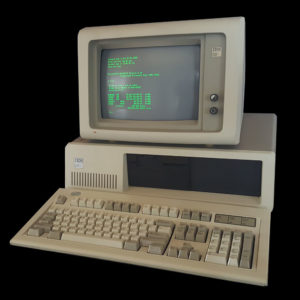 The IBM Model 5160 was as you might guess, a more powerful version of the IBM PC Model 5150. The ‘XT’ designation distinguished it from the 5150 ‘PC’. It was introduced in 1983 and, like it’s predecessor the IBM 5150, it was available with either a CGA colour video card or a monochrome (text-only) MDA video card. It shipped with more RAM on the motherboard and had 163W power supply to better support the supplied 10MB or 20MB hard disk drive (increased from the 93W PSU used in the 5150). The (mostly unused) tape port mysteriously disappeared – a sign of the times!... Read More...
The IBM Model 5160 was as you might guess, a more powerful version of the IBM PC Model 5150. The ‘XT’ designation distinguished it from the 5150 ‘PC’. It was introduced in 1983 and, like it’s predecessor the IBM 5150, it was available with either a CGA colour video card or a monochrome (text-only) MDA video card. It shipped with more RAM on the motherboard and had 163W power supply to better support the supplied 10MB or 20MB hard disk drive (increased from the 93W PSU used in the 5150). The (mostly unused) tape port mysteriously disappeared – a sign of the times!... Read More...
Apple 1
Posted by musovern on May 27th, 2019 in Apple, Vintage Computers | 1 comment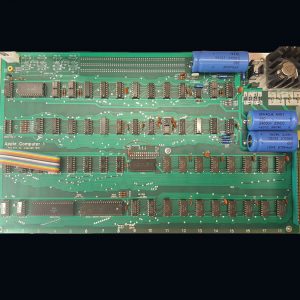
The story of the development of the Apple I is well known and has become a “legend”.
Steve Wozniak, who was working for Hewlett-Packard at the time, wanted to build his own computer. He couldn’t afford the Intel 8080 CPU, which was very popular, as it was used in the Altair 8800 and IMSAI 8080, but was very expensive. He would have used the Motorola 6800 but it was also much too expensive. Finally he decided to build his computer around the MOS 6502 CPU, which was pretty compatible with the Motorola 6800.
Read More...ZX-81
Posted by musovern on May 19th, 2019 in Sinclair, Vintage Computers | 0 comments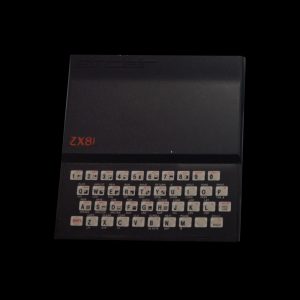
The ZX81 is a home computer that was produced by Sinclair Research and manufactured in Dundee, Scotland by Timex Corporation. It was launched in the United Kingdom in March 1981 as the successor to Sinclair’s ZX80 and was designed to be a low-cost introduction to home computing for the general public. It was hugely successful, and more than 1.5 million units were sold before it was discontinued. The ZX81 found commercial success in many other countries, notably the United States where it was initially sold as the ZX-81. Timex manufactured and distributed it under licence and enjoyed a substantial but brief boom in sales. Timex later produced its own versions of the ZX81 for the US market: the Timex Sinclair 1000 and Timex Sinclair 1500. Unauthorized clones of the ZX81 were produced in several countries.
Read More...TRS-80 Model 1
Posted by musovern on May 19th, 2019 in TRS80, Vintage Computers | 0 comments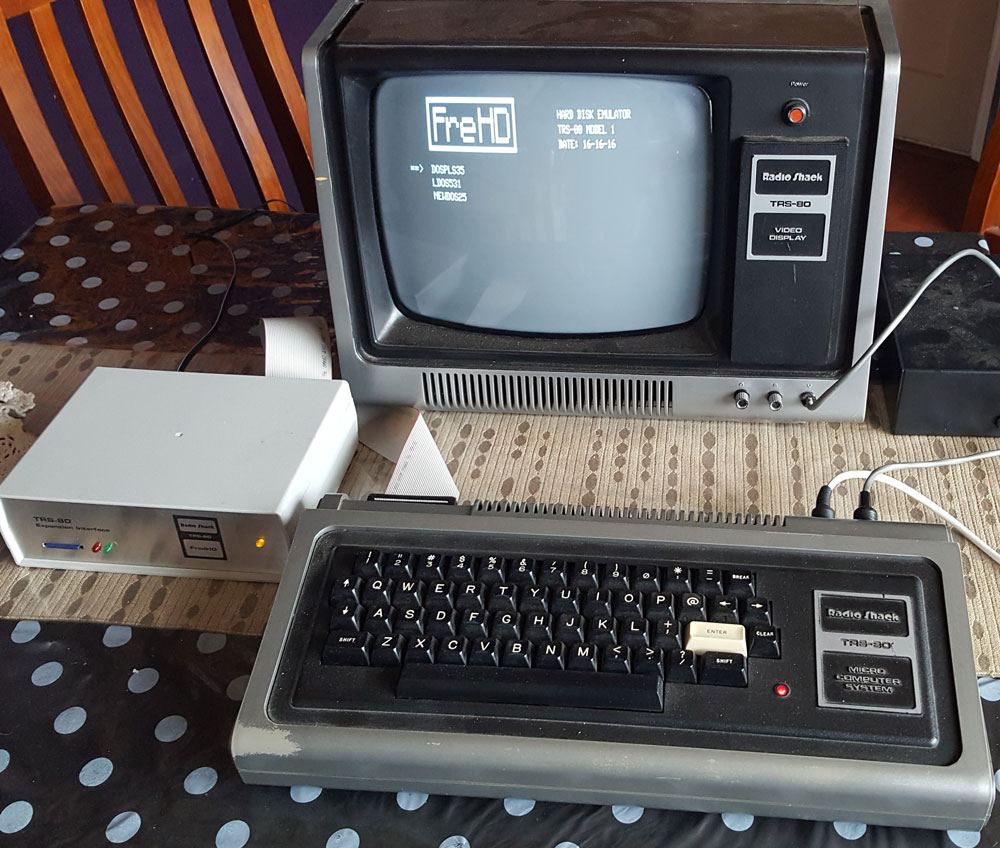
The Tandy TRS 80 model 1 was the first member of one of the most famous computer family. It was one of the first home computer and was launched at the same time as famous computers like the Apple II or the Commodore PET. Beside, Tandy competitors nicknamed was “Trash-80”.
The TRS-80 was developed was developed within the Radio Shack engineering group, based upon several processor chips, SC/MP, PACE, 8008, 8080 and finally the Z80.
It used a black & white TV set, made by RCA, without tuner as monitor. The earlier models use a poor basic called Basic Level 1 (the Basic and the OS fit in the 4 KB ROM!). It was replaced later with the Basic Level 2 which needed a 12 KB ROM.
Read More...Commodore 64
Posted by musovern on Apr 20th, 2019 in Commodore | 0 comments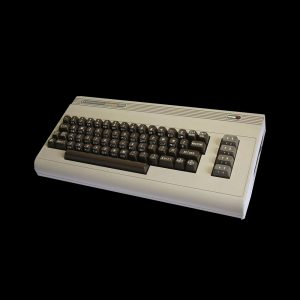
The Commodore 64 is an 8-bit home computer introduced by Commodore International in January 1982. Volume production started in the spring of 1982, with machines being released on to the market in August at a price of US $595.Preceded by the Commodore VIC-20 and Commodore MAX Machine, the C64 features 64KB (65,536 bytes) of memory with sound and graphics performance that were superior to IBM-compatible computers of that time. It is commonly known as the C64 or C=64 (after the graphic logo on the case) and occasionally as the CBM 64 (for Commodore Business Machines), or VIC-64. It has also been affectionately nicknamed the “breadbox” and “bullnose” due to the shape and color of the first version of its casing.
Read More...Amstrad PCW8256
Posted by musovern on Jan 30th, 2019 in Amstrad, Vintage Computers | 0 comments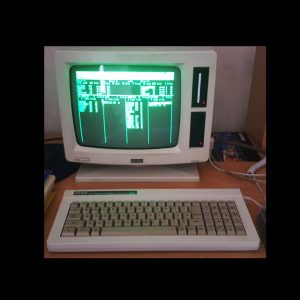
The PCW 8256 was launched in September 1985, and had 256 KB of RAM and one floppy disk drive. Launched a few months later, the PCW 8512 had 512 KB of RAM and two floppy disk drives. Both systems consisted of three units: a printer; a keyboard; and a monochrome CRT monitor whose casing included the processor, memory, motherboard, one or two floppy disk drives, the power supply for all the units and the connectors for the printer and keyboard. The monitor displayed green characters on a black background. It measured 12 inches (30 cm) diagonally, and showed 32 lines of 90 characters each. The designers preferred this to the usual personal computer display of 25 80-character lines, as the larger size would be more convenient for displaying a whole letter. The monitor could also display graphics well enough for the bundled graphics program and for some games.
Read More...Kaypro II
Posted by musovern on Sep 13th, 2018 in Kaypro II, Vintage Computers | 0 comments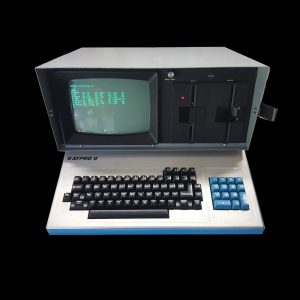
The Kaypro II was the first computer released by Non-Linear Systems, in 1982. Non-Linear Systems was founded by Andy Kay in 1952. But they didn’t make computers back then, they made digital multimeters. You see, Andy Kay is the inventor of the digital multimeter
The Kaypro II is unusual because the entire case is made out of metal. Kaypro’s computers were an extension of their test instrument design philosophy: rugged, reliable, reasonably priced, looking more like instruments than the creative, communications (and business) tools that they heavy.
Read More...SGS NBZ80-B Nanocomputer
Posted by musovern on Jun 27th, 2018 in SGS NBZ80 Nanocomputer, Vintage Computers | 0 comments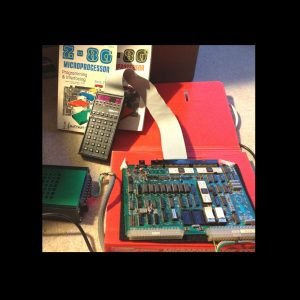
SGS NBZ80 Nanocomputer
This unit is the NBZ80-B: Nanocomputer base board with 2K ROM, Input Hex keypad device and power supply. Doc and Nanobook 1. Basically, the S without the experiment card NEZ-80.
Its manufacturer, SGS (Societa Generale Semiconduttore) is from Olivetti and Telettra, created in 1950. In 1960, the inevitable American founder Fairchild created in partnership with the Italian state SGS-Fairchild.
In 1971, SGS and Ates were merged by decree of the Italian Government, following the withdrawal of Fairchild in 1968 and the poor health of SGS.
After an agreement with Zilog in 1979 to create a second source for the Z80 and Z8000, it was finally the Mostek smelter that was bought in 1981.
In 1987, Thomson bought SGS to create SGS-Thomson Microelectronics.asically, the S without the experiment card NEZ-80.
Commodore VIC 20
Posted by musovern on Apr 30th, 2018 in Commodore, Vintage Computers | 0 comments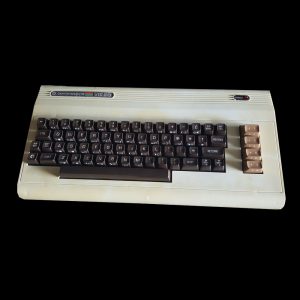
The VIC-20 was intended to be more economical than the PET computer. It was equipped with 5 KB of static RAM and used the same MOS 6502 CPU as the PET. The VIC-20’s video chip, the MOS Technology VIC, was a general-purpose color video chip designed by Al Charpentier in 1977 and intended for use in inexpensive display terminals and game consoles, but Commodore could not find a market for the chip.
Read More...Mac Color Classic
Posted by musovern on Apr 16th, 2018 in Macintosh, Vintage Computers | 0 comments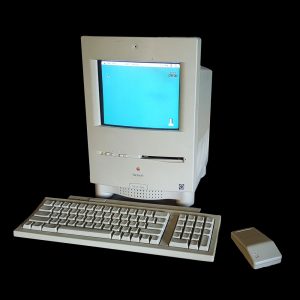
The Macintosh Color Classic was the first color compact Apple Macintosh computer. It was essentially a Macintosh LC II with an integrated 10″ Sony Trinitron color display with the same 512×384 pixel resolution as an LC II with the Macintosh 12″ RGB monitor. This integrated unit resembled the original Mac series, albeit slightly expanded, (see Macintosh Plus for an example), hence “Classic.” In Japan, Canada[2] and some other markets – but not the US – Apple later released the Color Classic II which was essentially the same case but with the LC 550 logicboard that doubled both RAM and speed. The Color Classic was also sold to consumers in the United States as the Performa 250, and the Color Classic II as Performa 275. The Color Classic was the final model of the original “compact” Macintosh family of computers.
Read More...Mac SE
Posted by musovern on Apr 16th, 2018 in Macintosh, Vintage Computers | 0 comments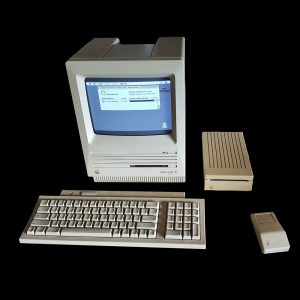
The Macintosh SE was a personal computer manufactured by Apple. This computer marked a significant improvement on the Macintosh Plus design and was introduced by Apple at the same time as the Macintosh II. It had a similar case to the original Macintosh computer, but with slight differences in colour and styling.
Read More...Mac Plus
Posted by musovern on Apr 16th, 2018 in Macintosh, Vintage Computers | 0 comments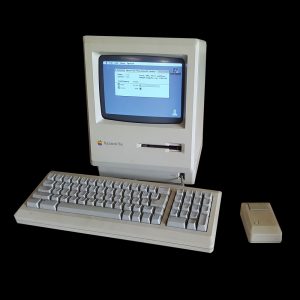
The Macintosh Plus computer was the third model in the Macintosh line, introduced on January 16, 1986, two years after the original Macintosh and a little more than a year after the Macintosh 512K, with a price tag of 2599 USD. As an evolutionary improvement over the 512K, it introduced RAM expansion from 1 MB to 4 MB, and the SCSI peripheral bus, among smaller improvements. It originally had the same generally beige-colored case as the original Macintosh (“Pantone 453”), but in 1987, the case color was changed to the long-lived, warm gray “Platinum” color.
Read More...